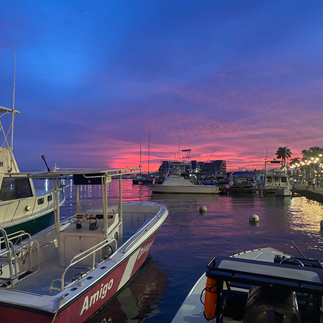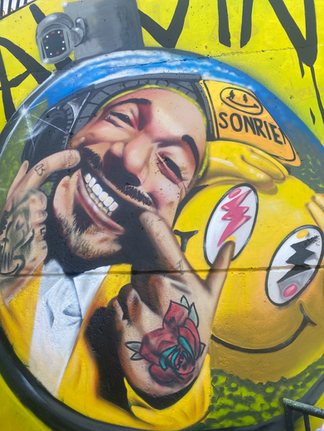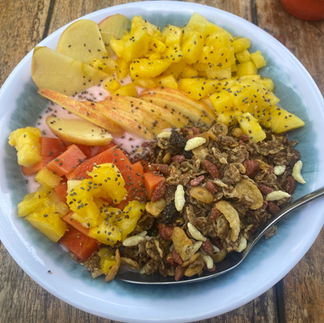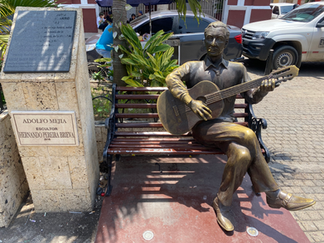Colombia (2023)
- Steph Fernandes
- Sep 10, 2023
- 15 min read
In August 2023, I visited Colombia and Aruba with a travel buddy. Colombia is a country in South America whose name derives from the surname of Christopher Columbus. It's known for coffee and cocaine production and the official language is Spanish, as it was colonised by Spain in 1525. We visited three of Colombia's biggest cities, starting in the capital, Bogotá, before heading to the former murder capital of the world, Medellín, and concluding the trip in the colourful Cartagena by the coast; each place was very unique and we learnt a lot about the (eventful) history and culture.
Bogotá
We started in Bogotá, spending three days here. Following about 16 hours of travel (and a Magnum double star chaser ice cream which I'd never had before but tasted like popcorn), we ordered an Uber to take us to our Airbnb. It's safe to safe I got quite a shock on entering the Uber, as the driver wanted to get us there as quickly as possible, however he was very sweet in ensuring we were at the correct destination and we arrived in one piece. I was also surprised by the landscape of this city (many apartment blocks with a mountainous backdrop) and by the flat that all apartment buildings had security.
The next day we walked around the old town, totalling 20km including a slight blip after lunch. We started with the Plaza de Bolívar, Simón Bolívar being involved in the independence of various countries in South America, including Colombia. This square was very busy, with a entertainment on a stage, and a beautiful church in the background, alongside the National Capitol. We then visited the Palacio de San Carlos, which had a mural on the exterior featuring a Portuguese emblem and artwork, however the reasoning behind this was unclear. After walking around the old town (La Capuchina) for about an hour, we had a traditional lunch: bandeja paisa. This dish consists of various meats, rice, beans, a fried egg, avocado, plantain and an arepa. This was the start of our downfall: the food itself was delicious, however we ordered one platter each, leaving us both feeling stuffed. We still had a long walk home and I was already feeling slightly nauseous. On our way home, we entered a church where someone was smoking a cigar, and a smell overcame me which caused me to exit the church, however I soon felt very faint; my legs started shaking and I felt incredibly hot and lightheaded. We decided to have a seat and drink some water before progressing home, and by the time we arrived I felt extremely nauseous. Luckily, after a nap we both felt much better and decided to head out to Plazoleta Chorro de Quevedo, a street lined with bars and restaurants for a drink. My first impression of the city was that there was a lot of homelessness (including people going through and eating out of bins), many people dressed alternatively, and a lot of men openly checking out the women.
The following day, we started off with breakfast in Juan Valdez, a café chain in Colombia, before heading towards the Graffiti District, which was cool but in a very industrial area just off the highway and fairly small. One thing to know about Bogotá is that there is street art on every corner so we were slightly disappointed by this district, as the artwork around the city was just as impressive and prolific. We spent the afternoon ambling through Simon Bolívar Park, which was serene, with no pollution, many families and dogs, and an abundance of kites everywhere. We then finished the day by exploring the Basilica Manor Nuestra Señora de Lourdes, which was very pretty indeed. This relaxing day allowed us to explore a completely different side of Bogotá, which was lovely to experience.
We commenced our final day in the city in Colo Coffee, which was nice but slightly overrated. We'd planned to spend this day visiting a couple of museums, however as we headed towards the old town we noticed a bit of commotion in Bolívar Square so decided to check it out. It transpired that a military parade was taking place with a marching band (one of my favourite things to run into). The sun was shining, musicians were out and about, and the old town came alive - it was nothing like how we'd witnessed it previously. We visited the Independence museum, where I learnt a lot, including that a vase is the symbol of independence for Colombians and that there wasn't a single event that led to Colombia's independence from Spain, but instead a myriad of events. We then popped into the Botero Museum, which was free on Sundays and mainly featured the work of a famous Colombian artist, Fernando Botero, who plays with proportion in his artwork. I enjoyed this museum greatly and would recommend visiting if you're in the city.
In the afternoon, we wanted to visit a fruit market in order to try some exotic fruits, which appeared to be a simple enough task, however we hadn't researched the route and ended up walking through some very questionable areas nearby slums where everyone made a point of staring at us, which was uncomfortable but didn't feel too dangerous. We arrived at the fruit market and I managed to practice my Spanish enough to obtain a Colombian 'maracuyá' (passion fruit), as well as a yellow dragon fruit, both of which were delicious. Unfortunately, they weren't selling mangosteens or curuba (a fruit that looks like a banana on the exterior and a passion fruit on the inside), so I wasn't able to try these. That said, we did manage to try a pandebono (traditional bread with cheese) so all wasn't lost. After making our way back to the Airbnb, it started pouring with rain so we got food delivered (after multiple disasters with their local food delivery company Rappi), and had a night in.
Aruba
It was at this point that NatWest decided to block my credit cards due to 'strange activity'. After calling them and trying to sort out the situation, the cards remained blocked (bar two transactions over the following 10 days), which was less than ideal. Nonetheless, the show had to go on, so we packed up bound for Aruba, a small Dutch island just off Venezuela. The official language is Papiamento (however most locals speak English, Spanish and Dutch too, which can be seen from the mix of road names) and the official currency is the Aruban Florin, however USD are widely used too.
We arrived at the airport to learn that Uber didn't exist here, and neither did any similar apps, meaning that we were reliant on taxis. The implications of this were made especially clear when we were charged USD 25 for the five-minute journey to our Airbnb and we realised that our Airbnb wasn't located close to anything. With no other choice, we got another taxi downtown and our first evening in Aruba was spent watching one of the most beautiful sunsets by the marina, and enjoying poke bowls and cocktails on the seafront. It was eerily quiet in the city centre, which was unexpected given that it was August, however the following day it all changed.
Overnight there was a big thunderstorm; I thought we'd left the shower on until I heard the booming thunder seemingly right above us, which woke us up a few times, followed by blinding lightning. We then awoke to a message from the Airbnb host stating that often following bad weather like this, power outages can occur. We had no food in the house and given the lack of nearby supermarkets, we were slightly nervous. It transpired that the thunderstorm was in fact tropical storm Franklin. Eventually, we decided to leave the house and walk to a nearby bus stop in the rain. We severely underestimated both the terrain and the duration, and when an old man pulled over to offer us a lift I was very tempted to accept but managed to refrain. We quickly realised that the bus was not a viable option and ended up getting another taxi from the airport to the city centre. This driver was lovely and even gave us his business card in order for us to use him throughout our stay.
It was supposed to rain all morning so we decided to treat ourselves to pancakes, given Aruba's link to the Netherlands. Unlike the previous evening, the place was now packed with tourists, specifically Americans, one of whom lost their mind over a pancake that was ordered incorrectly. Our taxi driver informed us that a cruise ship had docked and we saw Aruba transform into an American destination - they were everywhere and made their presence known. We spent our afternoon on Palm Beach, which started very cloudy but eventually got sunny (I ended up burnt despite the clouds). In the evening, we took a bus to the city centre, which was quick and cheap but came very irregularly and missed various stops. After heading to The Paddock for a local Balashi beer and a crab salad baguette, we headed home for a night of rest.
The following morning started fairly cloudy again, which wasn't filling us with confidence, especially given that this part of the trip was specifically intended to be spent on the beach. Regardless, we set off for breakfast at a restaurant named Santos, which I loved and I highly recommend - the coffee was great and the yoghurt with fruit, granola, and honey was incredible, not to mention the friendly waitresses. From here, we walked to the famous Eagle Beach, where we bought loungers and intended to wait out the raincloud above. Instead, the rain got heavier and heavier, to the point where we were jumping over the waves in the sea as the rain pelted our shoulders. This continued until the early afternoon, where I had to wring out our towels and we realised that we couldn't dry off or read, and that all of our belongings were soaked through. Instead, we headed to a beach bar for lunch and to escape the rain. Eventually, the sun came out and we finally got to experience the Aruba we'd signed up for.
The scenery was beautiful with white sand and clear skies and I loved swimming in the sea (it's one of my favourite things to do), however I noticed that the water was sticky - when I got out of the water to dry off, my skin and hair felt slightly sticky, which I'd never had before and didn't love. In these couple of hours I already started to burn as the sun was very powerful, so I went to the bar for happy hour and to FaceTime a friend at home for a couple of hours. We also enjoyed cocktails on the beach, followed by a beautiful sunset and a linguine clam dinner with wine, which was exactly what we needed.
Our final morning was spent packing and walking towards the airport, where a lovely local stopped us and offered us a lift instead, which we sincerely appreciated, as the sun was now in full force and the road wasn't in the best of conditions. Although we mostly saw Aruba in the rain, we were very grateful to have experienced a small slice of what Aruba had to offer. My main tip if you're wanting to visit Aruba is to ensure that the accommodation is near the city centre or at a resort (as the resort culture is strong here), or to rent a car if not. Furthermore, if you're wanting to see flamingoes, it's important to note that the flamingoes are only located on one beach, which is private but you can pay for a day trip or stay at Renaissance Aruba (a Marriott hotel) in order to see them.
Medellín
We flew to Medellín via Bogotá and during our layover, a lady separated the women from the men and made all the women show their passports, indicating that she was on the lookout for someone, which added a bit of a thrill to the layover. As it turned out, we weren't the target, so we then headed to Medellin and the views during the flight were beautiful, with green mountains galore. We rode an Uber to our Airbnb and our initial impressions of the city were that the roads were better than in Bogotá, the people were dressed less alternatively, and there was more to see. The high rises with the backdrop of mountains was reminiscent of Hong Kong, which I loved.
During our first evening, we went for dinner at a highly recommended restaurant for local food, and en route we saw one homeless man throw a water bottle at another homeless man, which kept us on our toes. We had a delicious meal (including a traditional ajiaco soup), however when I went to pay, the waiter first complemented my Spanish, then went on to tell us not to walk about the city at night, 'especially pretty girls like you', which was very uncomfortable as he compared us to local girls (note that it was only us left in the restaurant).
The following morning, I received the news that I'd passed my final exams and would never have to sit another exam in my life, which meant that celebrations were in order. But before that, we'd organised a walking tour in order to learn more about the history of the country, and explore the city that was once deemed the 'murder capital of the world'. We had breakfast at a local café, where we learnt that they only took cash, and after searching for an exchange bureau (to no avail) and the ATM not allowing me to withdraw cash, things were looking sticky. Nonetheless, my friend managed to get out some cash (albeit with high transaction fees) and we could go on our way. The meeting point for the walking tour was in a fairly dodgy area, where we saw multiple people limping and a guy with a fresh graze across his face. This was also the first place that I noticed locals wearing backpacks on their fronts, however I never felt unsafe.
Despite this, the walking tour itself was incredible and we learnt so much from the very passionate guide (who interestingly was also a lawyer). A few facts worth sharing are that:
Colombia produces 75% of global cocaine;
Pablo Escobar is widely disliked as his history is fairly recent so most people still remember losing loved ones to his cause and walking past corpses on their way to school or work;
Prostitution is legal but not regulated (and takes place right by the square dedicated to Botero's disproportioned sculptures);
Homelessness more than doubled in Medellin post-covid;
Smoking weed and drinking in public is legal; and,
History is not taught at schools in Colombia.
My favourite place was definitely Botero Square, however the former Palace of Justice (which is now a shopping centre) and the Parque de las Luces were also worth visiting, especially for their history. We tried 'cazuela frijoles' for lunch, which is similar to a Brazilian feijoada (or bean stew) and was delicious, but had a lot of meat in it. In the evening, we went to a nearby rooftop bar and enjoyed cocktails and the best nachos I've ever had in my life, with the lights on the mountains shining in the background, which reminded me greatly of Madeira. This was made even cooler by the frequent lightning in the distance.
On our second day in Medellín, we woke up to find a cockroach on the wall of our Airbnb which was an unwelcome surprise. After dealing with that, we put a wash on (which was perfect timing), before heading to brunch at a rooftop restaurant. The food was delicious, although they were out of coffee which was a shock to the system. We then headed to the 'Casa de Memoria', which had been recommended on the previous day's walking tour and was very interesting as we could hear personal accounts of the travesties that occurred in the country, including disappearances and homicides.
Our afternoon activity consisted of another walking tour, this time in 'Comuna 13', which was one of the places that I was most excited for as I love seeing street art and murals in new cities. There was a plethora of artwork, alongside musicians and dancers, which was incredible to see, however this place was packed and it was obvious that certain parts were made for tourists. That being said, I'd strongly encourage visiting as it's beautiful. The final spot of the walking tour was a basketball court, which the tour guide informed us had previously been a public execution spot, which was bleak but fascinating. After the tour ended, we took one of the cable cars up, where we enjoyed beautiful views of the city, followed by the metro, which the locals are very proud of as it is the only metro system in Colombia. We ended our evening in a Peruvian rooftop restaurant called Rocoto, where I had one of the best seafood pasta dishes I've ever had and is well worth visiting.
Cartagena
Cartagena is a a port city with beautiful architecture and was once the largest slave port in the Americas. I'd seen pictures of the city and was very excited to visit, however the main aim of this location was to relax on the beach. It was also where I stayed in my second ever hostel, however we stayed in a private room instead of a dorm, which was a novel experience.
Our room had a sea view from the balcony and the beach was less than a 100m walk from the hostel, which was very appreciated as the temperature was around 32°C. After arriving on our first day, we enjoyed e a delicious seafood rice lunch, then bought some towels and suncream and headed to the beach. One thing that immediately surprised me was how hot the water was; the water had been warm in Aruba but here it was even hotter than my showers tend to be. The water was less slimy than in Aruba but still slightly sticky and it was hard to fully dry off due to the humidity (as we'd immediately be clammy from the heat). Furthermore, my friend got stung twice by a jellyfish, people were racing motorbikes nearby, and a horse relieved itself on the beach. All in all, an eventful afternoon. Nonetheless, there was a rainbow in the distance (which was unexpected as it hadn't rained), and we were excited to meet others at the hostel and have dinner. What we weren't aware of was that we had to sign up for dinner (which we hadn't), so we ended up watching everyone else eat while we drank some beers, which was funny in hindsight but tragic at the time (luckily, we had some snacks in our room).
The next morning, we enjoyed some yoghurt and granola for breakfast and it was here that I got bitten by a couple more mosquitoes. Throughout the trip I'd been wearing mosquito repellent religiously, however on the three occasions that I let my guard down, I got bitten. Regardless, I was excited to finally see the beautiful city. Cartagena has a lot of history, some of which was noted on different plaques throughout the centre, and the city the filled with colour and art. Although the heat was verging on unbearable and I don't think I've ever sweated so much in my life (bearing in mind that I've been in over 40°C before and haven't sweated as much), I still loved exploring Cartagena.
That said, we did have an interesting lunch experience, where as we walked into a restaurant, everyone stared at us. There was some commotion in the courtyard, with multiple furious people shouting at two policemen, however we couldn't understand what was happening. More and more police officers kept arriving, increasing in seniority as they did so, and heading straight for the courtyard. The civilians had a lot of paperwork and we quickly realised that not only were we the only people eating, but that every other table seemed to be connected to the civilians outside. Eventfully, the manager came over to our table and although we didn't understand much, we understood him telling us that 'it has nothing to do with the restaurant' and not to worry. Then we heard him tell a waiter to 'lock the door with the key so that no one else comes in'. From then on, only more police officers entered and other officers guarded the door. I still have no idea what happened, but I imagine we'd walked in shortly after an armed robbery or similar. Despite this, the food was delicious and we were offered a 'tinto' on the house, which is a traditional coffee (and not a glass of red as I initially assumed).
Following the previous afternoon's eventful beach experience, we decided to spend our final day on a different beach: playa los morros. Apart from multiple vendors coming up to us, we had a lovely day on the beach, however at lunch I realised that I was already very burnt (and was still peeling from the burn in Aruba), so thereafter I made sure to stay out of the sun. We spent the whole day on the beach, before heading back to the hostel to get ready for dinner at a Japanese-Peruvian fusion joint. The food was delicious and the perfect end to the trip.
As we prepared for the first of three legs bound for the UK, a couple right next to us at Cartagena airport got incredibly angry, which led to them throwing a water bottle at a girl working in the café, as well as swearing at her, which was a horrible start to the journey, however before we knew it we were back in Heathrow safe and sound, where I was received with flowers, a coffee and a packed lunch, which was very much appreciated.
Final thoughts
Colombia is a beautiful country with a fascinating history and lots to offer. The weather varies considerably between the different regions with Bogotá around 20°C, Medellín around 27°C, and Cartagena around 32°C (in August). I learnt that most of the food is delicious, although a lot of the dishes involve multiple forms of meat on the same plate and I wasn't a huge fan of arepas or pandebono. One thing we noticed almost immediately and remained consistent throughout the trip was that men stare and check girls out completely shamelessly with not one ounce of subtlety, and are not short of compliments at all, with multiple men complimenting me on my Spanish, my British accent, and my hair, and calling us all sorts of things from 'hermosa' to Barbie. Furthermore, in Starbucks the waiters always write compliments on the cups and whenever you thank someone they reply with 'con mucho gusto', which I thought was very sweet. Finally, there are water fountains in all of the airports (and the tap water is potable) and throughout the country there is a strong kite culture and an abundance of artwork and music. Colombia was high on my list of countries to visit for years, and it was well worth the wait.















































































Comentarios